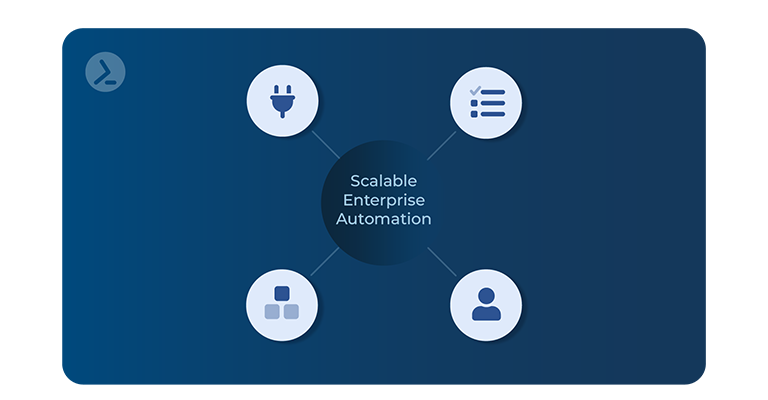AI adoption exposes critical weaknesses in enterprise automation coordination. Organizations rush to deploy AI capabilities while foundational system coordination challenges persist. Platforms that work in isolation now need seamless data flows to support intelligent decision-making. Employee onboarding requires identity provisioning, ITSM workflows, and automated resource allocation working in concert with AI agents. The right API integration strategy becomes the backbone that enables these intelligent workflows.
However, coordination gaps emerge at this critical point, undermining the overall effectiveness of AI. Current approaches create manual handoffs between identity systems, ITSM platforms, and execution environments. Breaks in automation prevent intelligent systems from accessing the complete data context needed for optimal decisions. When ServiceNow triggers workflows or identity systems initiate provisioning, AI agents need real-time visibility across all systems.
A sophisticated API integration strategy eliminates these friction points by creating seamless data flows that AI requires to deliver enterprise value.
Whether you're using ServiceNow, Jira, or another ITSM platform, the principle remains the same: automation must flow between identity, request, and execution layers. When your ITSM system triggers workflows or identity systems initiate provisioning across multiple platforms, automation becomes a controlled extension of IT operations. An API-first architecture hinges on four critical areas.
1. Design Systems for External Control
Most enterprise systems offer APIs as an afterthought. True API-first systems expect external triggers for every critical function. You'll design interfaces and security differently from the start.
Important API-First System Characteristics:
- External addressability: Every action executes via an API call, not just a GUI interaction
- Standardized protocols: Consistent, documented interfaces using REST or GraphQL
- Built-in security: Identity-aware access and token-based authentication by design
- Environment consistency: Operations behave identically across test and production
Your API integration strategy becomes critical when orchestrating across identity platforms like Entra ID, service layers such as ServiceNow, and execution environments like PowerShell. Without strategic API integration, orchestration fails, and scaling becomes impossible.
2. API Integration Strategy as Core Infrastructure
Enterprise automation typically stalls where systems cannot communicate effectively.
The breakdown typically occurs in three areas:
- ITSM tickets that generate no follow-up action
- Scripts that exist but cannot be securely triggered by external systems
- Approved requests that continue manually due to missing integration points
Beyond the noticeable delays, trust in automation erodes. IT teams create workarounds, and compliance becomes harder to track. When you treat integration as a core infrastructure instead of an add-on, these coordination problems disappear and enable true process automation across organizational boundaries.
3. Event-Driven Workflow Architecture
In a properly connected environment, employee onboarding turns into a traceable, automated workflow rather than a manual checklist:
- HR system trigger initiates the process
- ServiceNow captures and routes the request
- Approval flows through established channels via API
- Automated workflows handle user creation, group assignments, and resource provisioning
- Complete audit trails enable compliance reporting and risk management oversight
Platforms like ScriptRunner bridge the gap between intent and execution by connecting external requests with PowerShell logic. Integrated workflows give AI-supported systems comprehensive data context for intelligent decision-making. They ensure that actions are executed only when properly approved by authorized roles and with complete traceability.
Faster execution is obvious, but operational reliability across the enterprise matters more.
4. Architectural Requirements for Scalable Automation
Scaling automation across systems, teams, and regions requires moving beyond tool selection to define the operational framework within which automation functions. A well-planned API integration strategy serves as the backbone for this enterprise integration approach.
A scalable automation architecture requires five core components:

When these components are in place, teams no longer need to duplicate scripts or invent custom integrations. They simply stop building fragile workarounds. Instead of fragmented tools, automation becomes an operational capability with shared governance, standardized APIs, and system-wide reuse. Strategic integration must be designed from the start. Retrofitting APIs, after the fact, rarely deliver consistent, scalable results.
For example, Forrester's Total Economic Impact analysis of Azure Integration Services implementations found that organizations achieved a 295% ROI and $8.57 million net present value over three years, demonstrating how strategic API integration delivers measurable business results in practice. This ROI data supports the case for systematic implementation.
From Strategy to Execution
Begin with a pilot integration between two critical systems requiring manual handoffs. Choose systems with existing API capabilities and clear business impact, such as connecting your ITSM platform with identity management. This focused approach validates architectural principles while building organizational confidence in the API-first methodology.
Building an effective API integration strategy requires dedicated integration teams with clear mandates. Executive sponsorship includes quarterly API design reviews with security stakeholders. Standardized API libraries prevent teams from building custom point-to-point connections. Leverage existing system investments through API layers rather than replacing core infrastructure. Focus on creating a structure that connects your tools rather than controlling them.
Establish governance frameworks with clear decision rights, escalation paths, and stage-gate reviews. Define who approves API integrations, sets security protocols, and manages cross-system dependencies. Without these boundaries, teams default to tactical workarounds that undermine enterprise-wide automation.
Organizations require an integration architecture that delivers measurable automation performance, complete audit trails, and the ability to scale processes across business units without reengineering existing scripts.
For IT leaders, the objective is building an ecosystem where automation can evolve while maintaining visibility and operational trust.
Organizations that master this approach will find that their automation strategy investments finally deliver the enterprise-wide efficiency and control they were designed to provide.
Watch our expert webinar on scalable IT automation strategies to see how organizations are connecting their automation tools into cohesive, enterprise-wide workflows.

.svg)
.svg)

